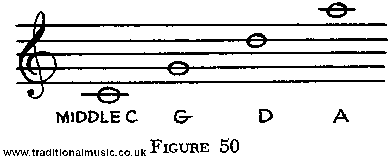It's Easy To Make Music
How To Play Tenor Banjo - notes
| Share page | Visit Us On FB |

easy to read. The notes, however, are an octave higher than
those to which the strings of the Tenor Banjo are tuned.
What the Tenor Banjo player does is to read the regular
notes and play from them. These notes, which correspond. to
the banjo's strings (although they are an octave higher) are
shown in Fig. 50.
When you see middle C in the music, you play your open
fourth or C string on the banjo. When you see the G above
middle C (Fig. 50), you play the open third or G string of your
banjo, and so on.
In piano and other standard music, you do not often find
notes below middle C. If you do see them, however, play them
as they are actually written. If you see the B directly below
middle C, for example, it is a note that you can actually make
on the G string of your Tenor Banjo. You play this B and it
sounds exactly like the B on the piano written in the same
position on the staff. The other higher notes from middle C on
up all sound an octave lower than they would sound on a piano.
This is a little difficult to explain in words, but we hope we
have made it clear. Don't puzzle over it too much at this point.
When you take your banjo and some music and start picking
out the notes, it will be clear to you after a very short time.
How the Banjo Is Played
The banjo is held so that it rests on the right thigh, when
you are seated, with the left hand holding the banjo's neck con-
siderably higher (Fig. 51). The strings are struck with a
tortoise shell pick or plectrum, which is held between the ball
of the right thumb and the right forefinger. The pick is laid
68